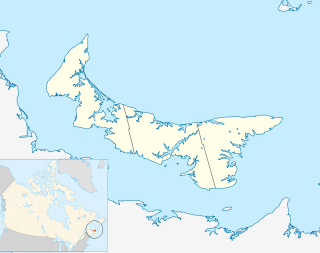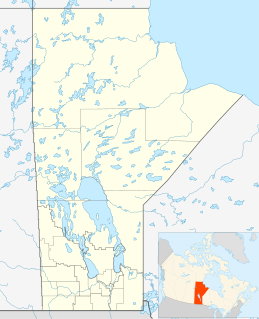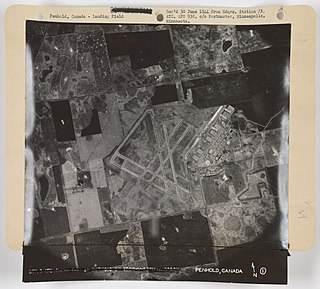
Canadian Forces Base Greenwood, or CFB Greenwood, is a Canadian Forces Base located 1.5 nautical miles east of Greenwood, Nova Scotia. It is primarily operated as an air force base by the Royal Canadian Air Force and is one of two bases in the country using the CP-140 Aurora and CP-140A Arcturus anti-submarine/maritime patrol and surveillance aircraft. Its primary RCAF lodger unit is 14 Wing, commonly referred to as 14 Wing Greenwood.

RCAF Station Vulcan, also referred to as RCAF Aerodrome Vulcan, was a Second World War flying training station located southwest of the town of Vulcan, Alberta, Canada. It was one of many stations that were established in Canada under the British Commonwealth Air Training Plan.

RCAF Station High River was a station of the Royal Canadian Air Force (RCAF) located at High River, Alberta, Canada.

RCAF Station Claresholm was initially a British Commonwealth Air Training Plan station that trained pilots for World War II service. The station was located near Claresholm, Alberta, Canada.

Centralia/James T. Field Memorial Aerodrome, originally RCAF Station Centralia,, is located 1.6 nautical miles west of Centralia, Ontario, Canada.

RCAF Station Saskatoon was a World War II British Commonwealth Air Training Plan (BCATP) base operated by the Royal Canadian Air Force (RCAF). It was located North of the City of Saskatoon, Saskatchewan, Canada.

RAF Station De Winton was a World War II air training station located south of Calgary, and east of De Winton, Alberta, Canada. The Royal Air Force (RAF) established No. 31 Elementary Flying Training School at the station. Like other RAF stations in Canada, it was subject to RCAF administrative and operational control.
RCAF Station Fort Macleod was a World War II British Commonwealth Air Training Plan (BCATP) flying training station. Administrative and operational control was the responsibility of the Royal Canadian Air Force (RCAF). The old station is located south of Fort Macleod, Alberta, Canada.

RCAF Station Mount Pleasant was a Royal Canadian Air Force (RCAF) station in Mount Pleasant, Prince Edward Island, Canada. Two of its runways remain in use by members of the Experimental Aircraft Association.

Several air force stations and other establishments, many of them training facilities, operated in Calgary, Alberta, Canada from the mid-1930s to the mid-1960s.

RCAF Station Assiniboia was a Second World War British Commonwealth Air Training Plan (BCATP) flying training station located near Assiniboia, Saskatchewan, Canada. It was operated and administered by the Royal Canadian Air Force (RCAF).

CFB Rivers was a Royal Canadian Air Force base located 5 km (3.1 mi) southwest of Rivers, Manitoba, Canada at the junction of Manitoba Highway 25 and Manitoba Provincial Road 259.

Canadian Forces Base Portage la Prairie is a former military airport located adjacent to Portage la Prairie, Manitoba, Canada. Today the airport is operated as Portage la Prairie/Southport Airport.

RCAF Station Brandon was a Second World War British Commonwealth Air Training Plan (BCATP) station located near Brandon, Manitoba, Canada. It was operated and administered by the Royal Canadian Air Force (RCAF).
No. 2 Air Navigation School was a navigation training school in No. 3 Training Command RCAF, of the British Commonwealth Air Training Plan("BCATP"), flying Avro Anson's from RCAF Station Pennfield Ridge. It was opened on 21 July 1941 and closed on 30 April 1942. A second school with the same number opened at RCAF Station Charlottetown on 21 February 1944 and closed on 7 July 1945.
No. 13 Service Flying Training School RCAF was a RAF flight training unit flying Avro Ansons from RCAF Station St Hubert, Quebec and later from RCAF Station North Battleford, Saskatchewan. It was part of No. 3 Training Command RCAF carrying out British Commonwealth Air Training Plan ("BCATP") operations.

RCAF Station Estevan was a World War II, British Commonwealth Air Training Plan (BCATP) base operated by the Royal Canadian Air Force (RCAF). It was located South of the City of Estevan, Saskatchewan, Canada.

RCAF Station Bowden was a Second World War British Commonwealth Air Training Plan (BCATP) station located near Bowden, Alberta, Canada. It was operated and administered by the Royal Canadian Air Force (RCAF).

RCAF Station Penhold was a Second World War British Commonwealth Air Training Plan (BCATP) station located near Penhold, Alberta, Canada.










